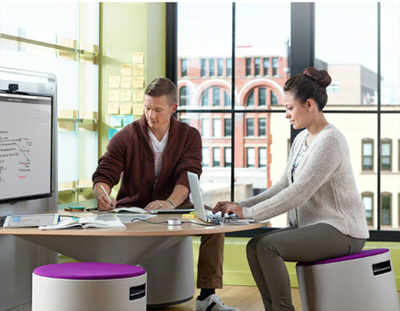- News
- lifestyle
- home-garden
- Setting up a new-age office? Read this now!
Trending
This story is from August 14, 2016
Setting up a new-age office? Read this now!
Ways to build a progressive and adaptable workplace which will boost employee productivity and engagement at a workplace.

According to a study, an office worker spends 5 years sitting at a desk. Imagine! If you spend so much time sitting at your workstations, do you not deserve a spacious, comfortable and a desk that boosts our productivity? But this is definitely not what most of the workplaces provide. It is vital that the workplace is designed to nurture the physical, cognitive and emotional needs of the employees.
However, only the right kinds of spaces can make this happen and thus we got in touch with Praveen Rawal, Managing Director, Steelcase (design consultant to the offices of Google, IBM, Deloitte, Accenture, TATASky and many more) to understand some ways to build a progressive and adaptable workplace which will boost employee productivity and engagement at a workplace.
1. Optimism: Fostering creativity and innovation
Optimistic employees tend to be more productive in today’s economy. They influence a wide range of behaviours such as seeing the big picture, exploring ideas, being open to others, taking more risks, facing difficult tasks and being open to change. These workers need to feel a sense of individual influence and control over their environment, versus feeling quashed by standardization and rigidity.behaviours such as seeing the big picture, exploring ideas, being open to others, taking more risks, facing difficult tasks and being open to change. These workers need to feel a sense of individual influence and control over their environment, versus feeling quashed by standardization and rigidity.
2. Cultivating mindfulness in the workplace
Mindfulness means balancing the intense pace of life with being fully present in the moment. Today technology presents many opportunities for multitasking, which allows people to be physically present in a meeting, but mentally lost in email. Workers need physical spaces that help them manage the cognitive overload of their daily lives and be fully present in the moment.

Image Credit: Steelcase
3. Cultivating authenticity in the workplace
Workers need spaces that make them feel encouraged to express their own ideas and values. Leaders set standards and a tone of authenticity, while customizable work environments and social settings can reinforce the message.
4. Cultivating interactive furniture settings
Research shows that providing spaces that support collaborative and heads-down activities increases engagement and productivity. Giving workers choice and control over where they work gives people a sense of ownership and allows them to work in ways that feel authentic and natural to them.
5. Cultivating vitality in the workplace
How we experience a place affects our actions. Investments in the workplace can completely change the attitude and behavior of employees, creating a new spatial vibe that boosts their motivation and performance within a relatively short time.

Image Credit: Steelcase
These spaces can provide employees options for different modes of work and promote individual employee wellbeing—and thus improve retention—as well as advance other business goals.
However, only the right kinds of spaces can make this happen and thus we got in touch with Praveen Rawal, Managing Director, Steelcase (design consultant to the offices of Google, IBM, Deloitte, Accenture, TATASky and many more) to understand some ways to build a progressive and adaptable workplace which will boost employee productivity and engagement at a workplace.
1. Optimism: Fostering creativity and innovation
Optimistic employees tend to be more productive in today’s economy. They influence a wide range of behaviours such as seeing the big picture, exploring ideas, being open to others, taking more risks, facing difficult tasks and being open to change. These workers need to feel a sense of individual influence and control over their environment, versus feeling quashed by standardization and rigidity.behaviours such as seeing the big picture, exploring ideas, being open to others, taking more risks, facing difficult tasks and being open to change. These workers need to feel a sense of individual influence and control over their environment, versus feeling quashed by standardization and rigidity.
| Design Considerations for such employees: 1. Allow choice and control over where and how people work. 2. Create spaces that allow personalization and individual customization, instead of tightly enforced workplace standards. 3. Offer settings and affordances that help employees feel supported in their work. 4. Design for transparency, so that people can see and be seen and build trust. |
2. Cultivating mindfulness in the workplace
Mindfulness means balancing the intense pace of life with being fully present in the moment. Today technology presents many opportunities for multitasking, which allows people to be physically present in a meeting, but mentally lost in email. Workers need physical spaces that help them manage the cognitive overload of their daily lives and be fully present in the moment.
| Design Considerations: 1. Create spaces that help people connect with others one-on-one and eye-to-eye and not just through their technology devices. 2. Design areas that allow workers to control their sensory stimulation and choose if they want to amp it up or down. 3. Offer places that are calming, through the materials, textures, colors, lighting and views. 4. Create areas where people can connect with others without distractions or interference. |

Image Credit: Steelcase
3. Cultivating authenticity in the workplace
Workers need spaces that make them feel encouraged to express their own ideas and values. Leaders set standards and a tone of authenticity, while customizable work environments and social settings can reinforce the message.
| Design Considerations: 1. Incorporate informal or non-constricting environments which feel like a home. 2. Design areas that help people connect their personal values to the brand values |
4. Cultivating interactive furniture settings
Research shows that providing spaces that support collaborative and heads-down activities increases engagement and productivity. Giving workers choice and control over where they work gives people a sense of ownership and allows them to work in ways that feel authentic and natural to them.
| Design Considerations: 1. Collaborative spaces, with or without walls, and single-use focus rooms give users a variety of spaces to choose from and be comfortable with. 2. Place sofas and soft benches for lounge posture and stools for. |
5. Cultivating vitality in the workplace
How we experience a place affects our actions. Investments in the workplace can completely change the attitude and behavior of employees, creating a new spatial vibe that boosts their motivation and performance within a relatively short time.
| Design Considerations: 1. Design areas that give people choices for controlling the level of sensory stimulation around them. 2. Provide easily adjustable furniture to fit a range of sizes, needs and preferences and to promote movement throughout the day. 3. Include cafés with healthy food choices and displays. 4. Bring nature in with daylight, views, ventilation, patios, etc. 5. Support active, healthy lifestyles with centrally located stairways, outdoor walking paths, bicycle racks, etc. |

Image Credit: Steelcase
These spaces can provide employees options for different modes of work and promote individual employee wellbeing—and thus improve retention—as well as advance other business goals.
End of Article
FOLLOW US ON SOCIAL MEDIA








